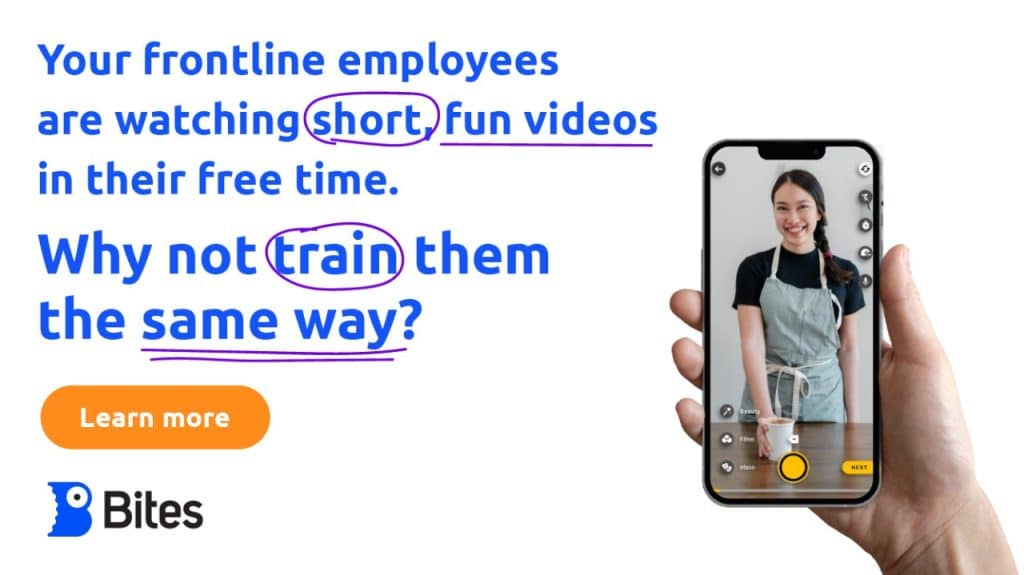“Training content, not raining materials” webinar transcript part 1
Here’s a recap of Tal Almog’s and Gili Fleekop’s discussion that took place at our webinar – Training Content, Not Training Materials.
Many interesting questions were raised, and answered by Tal and Gili:
- What are old vs new ways of training?
- What is the difference between training content and materials?
- How Gen Z employees learn best?
Read the summary or watch the full webinar recording.
Gili Fleekop: [00:01:46] Our agenda today, we’re first going to start out by talking to Tal Almog. We’re going to talk about the why, the what, and the how of training content.
Gili Fleekop: [00:03:02] I would love to welcome Tal to the virtual stage. Tal Almog has over 15 years of experience in the field of learning and e-learning, and she currently serves as the chief operating officer at Bites, which is a training platform for training and ongoing training
Gili Fleekop: [00:04:08] What are some of the old versus new ways of training?
Tal Almog: [00:04:37] When we speak about the new ways and methods of training, it’s all about user experience. Think about instant messaging, Instagram, TikTok, all those things they need and must define, the way we train today. We will all agree that when it comes to training, it’s not only about the content. It’s actually a puzzle with many pieces that complete each other to a great training process. We must make sure that each piece is treated with this approach. If we want to create a comprehensive and complete a training process that speaks the language of now.
Gili Fleekop: [00:07:16] I have to ask the question of the hour, the name of the webinar title, a really, really interesting question of “What really is the difference between training content and training materials?”
Tal Almog: [00:07:30] The bottom line is that training materials today, training materials are the basis for training content. when we build a training program, we conduct a very comprehensive process, we define the goals, we define the audience, we understand who our professional experts are and what is the information that needs to be delivered to our employees. The outcome of this process is the materials. set of files, presentations, sometimes videos, that are very organized that cover all the information that needs to be delivered. And sometimes they’re almost ready to share with our employees. In all those format files, presentation long videos, they are great, we must have them. But based on them we must take step forward and create the content. It must be engaging, appealing.
Gili Fleekop: [00:10:17] Can you elaborate a little bit more on how do we define training content?
Tal Almog: [00:11:51] The first is that content must be short. Content must be short, but it doesn’t mean that we can’t deliver long courses and complicated processes in digital platform. It means that everything should be divided into small pieces to nuggets. They must be sweet and tasty. It has to be something that actually make people want to take the next bite. The second thing is to have the materials as a basis. A basis that is very organized and contains all the information that the employee actually needs. That content, the way we wrap it and share it with employees must be based on media.
I want to mention the fact that is super important today that content will be interactive as well. it’s our way as the trainers to mail the message for the learner and it’s also our way to monitor understanding. I would like to emphasize that, by that I don’t mean long quiz after a long video. That won’t do the job, this is not the way. A nugget and interaction. Nugget and interaction, this is the way we build a new training process that again, speaks the language of a Gen-Z people.
What I want to mention here is that training is affected a lot by the trend of creators economy. Today, everyone, anyone is a potential content creator. We all create stories, Tiktoks, etc. And this is something great and we as training managers, training experts, even CEOs, owners, operation managers, we can use this trend and create an internal community of content creators inside the company. It actually contributes a lot to the training culture in the business. We see that internal influencers are growing inside the company. They create lots of professional content and I will speak about it later again.
Gili Fleekop: [00:19:09] What trends are we seeing when it comes to Gen Z employees and how they learn best and consume professional information within the work environment?
Tal Almog: [00:19:57] I think that you can be the best person to elaborate about it as Gen Z content creator and as Gen-Z. So, go ahead.
Gili Fleekop: [00:20:26] the biggest trend we’re seeing when it comes to Gen-Z consumers, viewers, audience members, employees, even in that in their free time, is that we’ve really left the digital age of this picture perfect, scripted, perfect Instagram feed, right? We’re seeing a complete shift over to people craving authenticity. I’m really interested to see how it overlaps into the training world.
So, I just want to ask, when it comes to training content, what effect are we seeing? What’s the impact here?
Tal Almog: [00:22:01] First of all, the overall engagement. it’s super, super challenging to create engagement with the ongoing updates, communications training, which are super important for the business. And we see that when it comes to a good content, the engagement rate are super high even when it comes to the ongoing and people are asking for more and more and more content because they enjoy it. The second thing, if we’re getting a real engagement is that we see lots of interactions, especially when we enable a chat. people consume the content, they love it, they speak about it, they share things around it.
Tal Almog: [00:25:32] I would mention one more thing we need from the company angle, from the managers, the content creators, we see that more content is being created in the company. When the company enables people to create this authentic content in a simple way, which is, we said before, much more engaging and effective. But when the company enables them to do so, it’s much simpler and faster to create content and to make sure that people are consuming. They are becoming like internal influencers, internal celebrities.
Gili Fleekop: [01:05:30] What tools does Bites have in place that we can utilize for engagement with training, for example? Is there a way built in to ask questions? Additionally, if you ask someone to explain back to you a topic they’ve learned, can you see how they’ve absorbed information and whether there are any gaps?
Tal Almog: [01:05:58] Bites is a platform for training and ongoing professional communication. The platform enables companies to create content. Not only to create the video in a social media style, but also to create short learning cycle. We call each learning unit, learning cycle, a Bite. And when we want to create a long course we can create a playlist of Bites. You can add all kinds of elements to the content, like questions, chats, a summary cards to make sure that the main points are clear. There is a very advanced analytics dashboard that enables you to monitor actually everything you need. We know to customize the dashboard for specific needs. In terms of gaps or how people consume the content, it is something that you can actually see through the dashboard, there is full transparency. Bites can integrate with any channel. You can integrate to a few channels at the same time to send content via WhatsApp, SMS, email at the same time.





